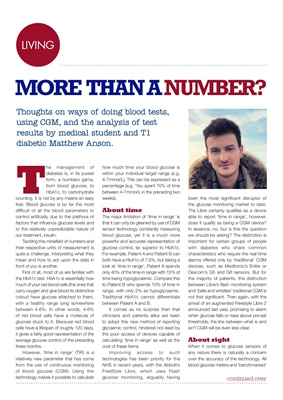
LIVINGLIVING
MORE THAN A NUMBER?
T
he management of
diabetes is, in its purest
form, a numbers game,
from blood glucose, to
HbA1c, to carbohydrate
counting. It is not by any means an easy
feat. Blood glucose is by far the most
difficult of all the blood parameters to
control artificially due to the plethora of
factors that influence glucose levels and
to the relatively unpredictable nature of
our treatment, insulin.
Tackling this minefield of numbers and
their respective units of measurement is
quite a challenge, interpreting what they
mean and how to act upon the data in
front of you is another.
First of all, most of us are familiar with
the HbA1c test. HbA1c is essentially how
much of your red blood cells (the ones that
carry oxygen and give blood its distinctive
colour) have glucose attached to them,
with a healthy range lying somewhere
between 4-6%. In other words, 4-6%
of red blood cells have a molecule of
glucose stuck to it. Because red blood
cells have a lifespan of roughly 120 days,
it gives a fairly good representation of the
average glucose control of the preceding
three months.
However, 'time in range' (TIR) is a
relatively new parameter that has come
from the use of continuous monitoring
of blood glucose (CGM). Using this
technology makes it possible to calculate
how much time your blood glucose is
within your individual target range (e.g.
4-7mmol/L). This can be expressed as a
percentage (e.g. 'You spent 70% of time
between 4-7mmol/L in the preceding two
weeks).
About time
The major limitation of 'time in range' is
that it can only be gleaned by use of CGM
sensor technology constantly measuring
blood glucose, yet it is a much more
powerful and accurate representation of
glucose control, far superior to HbA1c.
For example, Patient A and Patient B can
both have a HbA1c of 7.5%, but taking a
look at 'time in range', Patient A spends
only 40% of the time in range with 15% of
time being hypoglycaemic. Compare this
to Patient B who spends 70% of time in
range, with only 2% as hypoglycaemic.
Traditional HbA1c cannot differentiate
between Patient A and B.
It comes as no surprise then that
clinicians and patients alike are keen
to adopt this new method of reporting
glycaemic control, hindered not least by
the poor access of devices capable of
calculating 'time in range' as well as the
cost of these items.
Improving access to such
technologies has been priority for the
NHS in recent years, with the Abbott's
FreeStyle Libre, which uses Flash
glucose monitoring, arguably having
been the most significant disruptor of
the glucose monitoring market to date.
The Libre certainly qualifies as a device
able to report 'time in range', however,
does it qualify as being a CGM device?
In essence, no, but is this the question
we should be asking? The distinction is
important for certain groups of people
with diabetes who share common
characteristics who require the real-time
alarms offered only by 'traditional' CGM
devices, such as Medtronic's Enlite or
Dexcom's G5 and G6 sensors. But for
the majority of patients, the distinction
between Libre's flash monitoring system
and 'bells and whistles' traditional CGM is
not that significant. Then again, with the
arrival of an augmented Freestyle Libre 2
announced last year, promising to alarm
when glucose falls or rises above pre-set
thresholds, the line between what is and
isn't CGM will be even less clear.
About right
When it comes to glucose sensors of
any nature there is naturally a concern
over the accuracy of the technology. All
blood glucose meters and 'benchmarked'
Thoughts on ways of doing blood tests,
using CGM, and the analysis of test
results by medical student and T1
diabetic Matthew Anson.
continued over